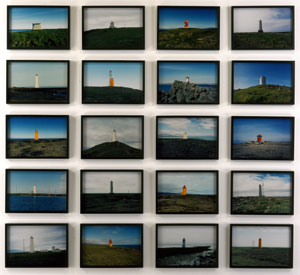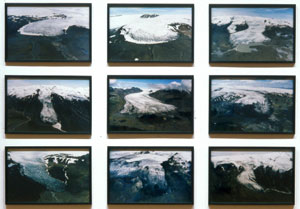Olafur Eliasson seems to have been everywhere of late, using elemental forces and state changes (light to heat, wet to dry, water to vapor) to create boisterous installations that turn the predictable purposes of exhibition architecture inside out.

Olafur Eliasson... The landscape series, 1997 ... 30 C-prints... 94 1/2 x 155 1/2 in. (240 x 395 cm.)
Last year alone he inverted the massive scale of the Tate Modern, turned the Danish Pavilion of the Venice Bienale into a kind of twisted treehouse, and subverted the original, floral purpose of Madrid’s Crystal Palace in favor of a lunar landscape populated by a host of otherworldly structures. Born in 1967, Eliasson is a relatively young artist, but a clear formal structure has begun to emerge in his work. His installations are based on natural models (at his Menil Collection lecture, one slide of his studio showed a room full of enlarged crystal structures), which he positions within the predetermined arena of an architectural space. The images that comprise this ten-year photographic survey are, like his crystal models, points of departure for future consideration. The space they occupy is not the singular, neutral space of the white-matted traditional photograph. Rather, they assume group identities as part of larger, gridded compositions. 31 such assemblages and 29 related works, made between 1994 and 2003, comprise this first survey of his photography,
Eliasson was born in Copenhagen but he grew up in Iceland, and that island country’s unusual landscape — equal parts fire, air, and water — remains his constant source of inspiration. While he has photographed other landscapes in other parts of the world, he sites “a distinct personal knowledge of Iceland — its history and its geology” as the reason so much of his photographic work records this country’s peculiar topography. The singularity of his relationship with this landscape is clear in The island series (1997), which juxtaposes 32 images of small islands off the central Icelandic coastline. Arranging them in a vertical stack, four across and eight down, Eliasson shifts the size of his frames in descending order, so that when the islands are furthest away and most closely linked with the horizon, they are slender horizontals, gradually increasing their height so that by the bottom row, where the islands are most frame-filling, the format increases to approximate the traditional proportions for a marine painting stretcher. Confounding our tendency to read gridded images top to bottom and left to right, or to perambulate randomly between images, Eliasson structures his filmstrip-like progression so that what appear to be four separate islands seem to traverse from far distance to foreground close-up as we scan from top to bottom.
Three cave series from 1998 are included in the exhibition, and they are among Eliasson’s best works. The cave series, looking in assembles 49 portraits of cave orifices. In most of these works the skyline is either shifted very high in the composition or is totally absent, so that each cave’s mouth is privileged and personified as a dark void. In the companion The cave series, looking out tonalities are reversed, and each cave mouth is as an inhabitant would see it — a glowing white absence surrounded by dark. Finally, The inner cave series portrays the earth’s internal landscapes from an intruder’s perspective. Reading these series one after the other, it is easy to see why Eliasson prefers to use photography as an inspirational rather than documentary tool, and how strongly these photographs, even as they exist as self-contained artworks, shape the look and feel of his installations.
There is nothing new about gridding photographs. In his choice of format Eliasson would appear to be emulating the influential typological strategy espoused by Bernd and Hilla Becker. But aside from this format’s explicit prompt to read every assemblage of similar subjects as a visual compare-and-contrast essay, this work is far too personal and experiential to be seen as strictly typologic. Eliasson’s approach might suggest comparisons with indexical works like Gerhard Richter’s Atlas or Ellsworth Kelly’s photographic collages, but Eliasson is as relentlessly specific about his subject matter as Richter and Kelly are omnivorous and magpie-like in their search for the next shiny shard of visual information.
Formally, Eliasson’s penchant for recording representational imagery as a spark for his largely abstract installations is perhaps most similar to Ad Reinhardt’s collection of more than 10,000 sequenced photographs of details acquired during his worldwide travels in the 1950s. Like Reinhardt, Eliasson readily dispenses with the modernist purity of full-frame photography, cropping to position his subject (an architectural detail for Reinhardt, a naturally occurring formation for Eliasson) dead center. And both artists carefully disconnect the very detailed nature of their photographic records from the almost dematerialized atmospheres they create in their best-known works.
But Eliasson’s photographs most directly evoke the spirit of Robert Smithson, especially in his Non-Sites and Mirror Displacements, where the “unreality” of the photographic evidence and the palpable but totally decontextualized “reality” of natural materials is always being juggled. The two artists also share a general sense of irascibility. Smithson is remembered for the seemingly pristine naturalness of the Spiral Jetty, but some of his best works were conceptual essays, illustrated with photographs, such as A Tour of the Monuments of Passaic, New Jersey, which recontextualized and rehabilitated woe begotten, marginal, or abandoned landscapes degraded by human activity. The evident playfulness with which Eliasson unzipped the stodgy confines of the Danish Pavilion for last year’s Venice Bienale has a similarly refreshing sense of artist as free radical in an overly-determined world.
There are a few things Eliasson does not do well, and including figures in his photographs is one of them. The figures in looking for hot water on Gunnar’s land (1995) and The Chinese series (1997) reduce the landscape to a prosaic backdrop, and the grid to a narrative device. Unlike his architecturally-based installations, where human presence is the essential activating device, humanity intrudes here. Eliasson has no such problems using architectural elements as figurative surrogates, however. The lighthouse series (1999) and Reykjavik series (2003) place buildings in the same center-stage position he accords his glaciers, fissures, caves, islands, paths, and stones. The verticality of a lighthouse makes it a perfect counterpart for a standing figure, and Eliasson takes pleasure in pointing out their isolated, diminutive relation to the land by framing 20 of them so that they are no closer than middle distance. Reykjavik series is a twisted typology of 72 building facades that plays with space to shape a fluid correspondence between shapes of habitation and shapes of presentation, ranging from large and rectangular in the upper left corner to small and nearly square in the lower right, and from horizontal sliver at lower left to slender vertical at upper right. Eliasson’s best photographs are raw — both in the sense of raw material, and in their primal directness. This is a romantic viewpoint, but then this is romantic work — harshly romantic and intensely interesting.
Olafur Eliasson: Photographs remains on view at the Menil Collection through September 5. An illustrated catalogue featuring an essay by exhibition organizer Matthew Drutt and a dialogue between Drutt and Eliasson accompanies the exhibition.
All images appear courtesy the artist and The Menil Collection.
Christopher French is an artist and writer living in Houston.





